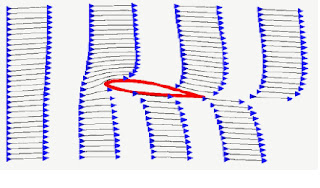Four forces acting on an aircraft in flight.
 The three Axis of Rotation
The three Axis of Rotation
 a. Aircraft. Any weight-carrying device designed to be supported by air, either by buoyancy or by aerodynamic reaction.
a. Aircraft. Any weight-carrying device designed to be supported by air, either by buoyancy or by aerodynamic reaction.
b. Airfoil. A surface so designed as to produce an aerodynamic
reaction to its direction of motion.
c. Airspeed. Speed of the aircraft in relation to the surrounding air.
d. Angle of Attack. The angle between the relative air flow and the chord of the airfoil.
e. Angle of Incidence. The angle formed between the chord and the longitudinal datum line.
f. Aspect Ratio. The ratio between the span and the chord.
g. Camber. The curvature of the wing.
h. Centre of Gravity. The balance point.The point through which all weight acts downwards.
j. Centre of Pressure. The point along the airfoil chord of the body axis through which the resultant aerodynamic force acts.
k. Chord. An imaginary line from the leading edge to the trailing edge of an airfoil.
m. Dihedral. The angle each wing makes with the horizontal.
n. Drag. The total resistance to the aircraft in flight.
p. Equilibrium. Balance between forces, when opposing forces are equal.
q. Fin. Vertical stabilizer.
r. Groundspeed. The relation between the speed of the aircraft and a point on the ground.
s. Lateral Axis. An imaginary line running from wing tip to wing tip through the centre of gravity.
t. Longitudinal Axis. An imaginary line extending through the fuselage from the nose to the tail.
u. Mainplane. Main supporting airfoil (wing) of the aircraft.
v. Pitching. Movement around the lateral axis.
w. Rolling. Movement around the longitudinal axis.
x. Span. Measurement from wing tip to wing tip.
y. Stable. An object is stable if, when disturbed, it returns to its original position.
z. Stabilizer. Any surface of airfoil shape whose primary function is to correct instability of an aircraft in flight.
aa. Stalling Angle. The angle of attack of an airfoil where the smooth airflow breaks away and becomes turbulent.
ab. Sweepback. Outward and backward angle of the leading edge of the mainplane.
ac. Tailplane. Horizontal stabilizer.
ad. Turbulence. Disturbed air flow.
ae. Unstable. An object is unstable if, when disturbed, it continues to move farther and farther from its original position.
af. Venturi. A variable section tube wider at each end than in the middle.
ag. Vertical Axis. An imaginary line running at right angles to the longitudinal and lateral axes through the centre of gravity.
ah. Wing Tip Vortices. Spiralling air at the wing tips caused by high-pressure air from the lower surface of the airfoil moving into the low-pressure air on top of the airfoil.
ak. Yawing. Movement around the vertical axis.


